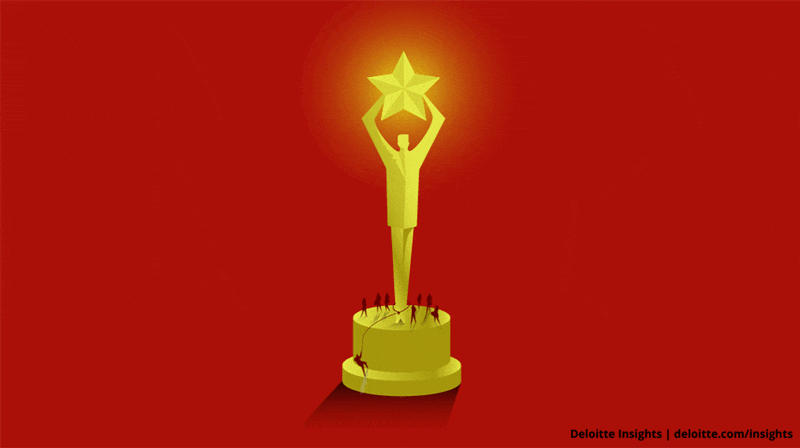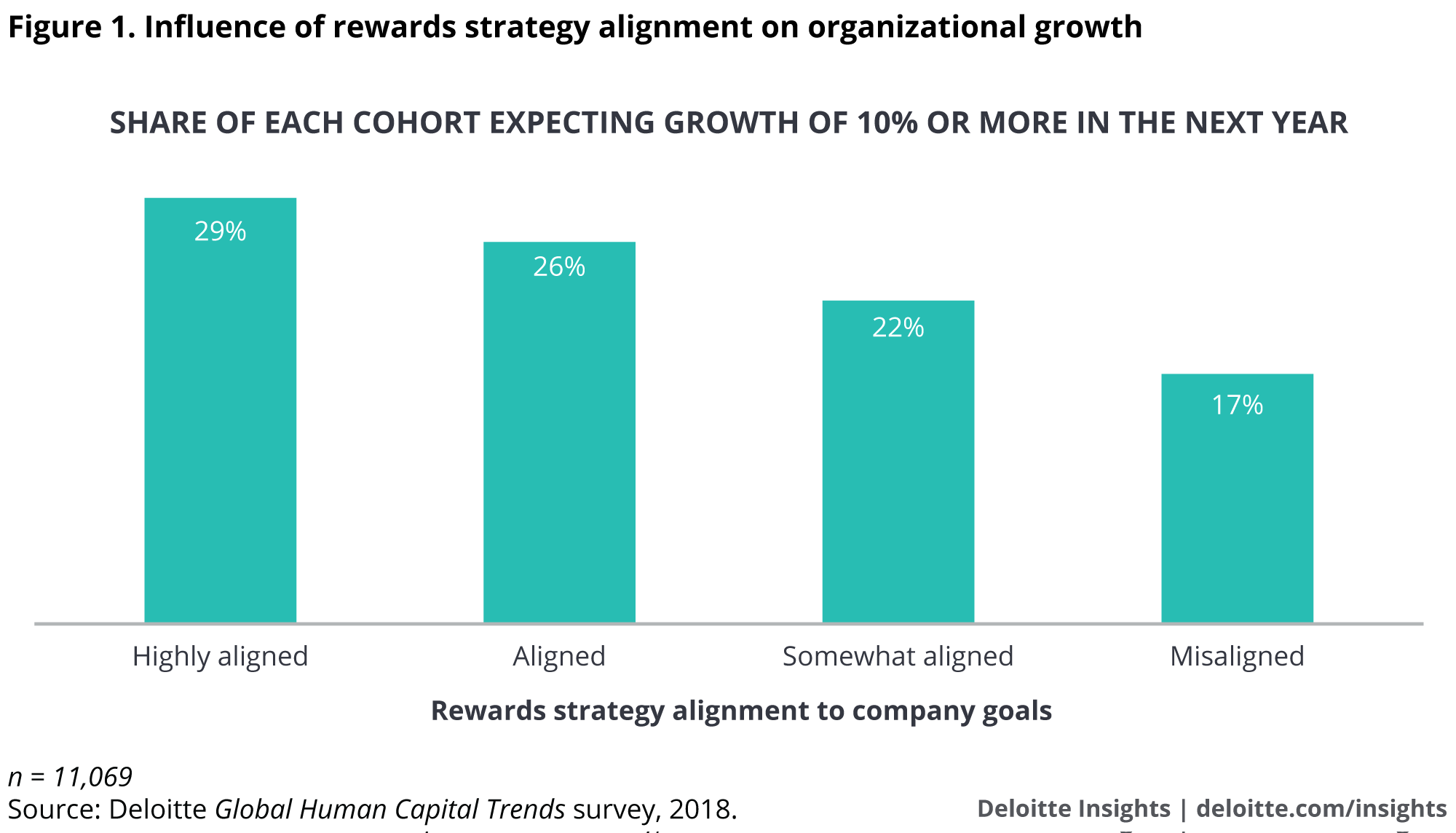
New rewards: Personalized, agile, and holistic 2018 Global Human Capital Trends
28 March 2018
Why have rewards remained stuck in the past, when almost every other aspect of HR has undergone transformative change? Leading companies are now undertaking the hard work of creating personalized rewards programs based on understanding each individual’s needs.

A shift toward tailor-made rewards
Learn more
View 2018 Global Human Capital Trends
Explore the infographic
Watch the video
Read the press release
Download the full report or create a custom PDF
For decades, designing rewards programs was a relatively straightforward exercise of finding the right mix of compensation and traditional benefits such as health insurance and vacation time. Those days are over. Leading organizations now understand that a personalized, agile, holistic rewards system is essential to attracting, motivating, and developing talent. So why are so many companies falling short, even as they realize their rewards programs are outdated?
Rewards are in the midst of a transition from the strictly standardized to the highly personalized. Companies at the forefront of this wave are creating rewards programs that are delivered more continuously, aligned more closely with individual preferences, and based more fully on an employee’s whole contribution—to the team and the organization. These companies understand that effective rewards programs require a personal relationship with each worker. Done correctly, this new approach to rewards can become a huge competitive advantage.
An aligned rewards strategy correlates with high growth expectations
Respondents from organizations whose rewards strategies were highly aligned with organizational goals were the most likely to anticipate growth of 10 percent or more.

Explore the data further in the Global Human Capital Trends app.
Yet our research indicates that few companies are making this transition successfully. Yes, they understand the need; 76 percent have reinvented performance management to be more continuous. However, 91 percent of companies still follow the utterly conventional practice of conducting salary reviews only once a year—or even less often.1 Even worse, organizations rate their rewards program with a net promoter score of -15, and only 21 percent would recommend their program to others.2
Many business as well as HR leaders recognize the problem. In this year’s Global Human Capital Trends survey, 37 percent of respondents rated rewards as very important, yet only 9 percent indicated that they were “very ready” to deal with this challenge.
From this low baseline, we did additional research to try to understand how well rewards systems are driving business outcomes. The results are shockingly poor (table 1).3

These low numbers point to a serious problem. While other talent strategies have evolved, rewards practices are lagging behind.
What is wrong with rewards?
We see three major areas where today’s rewards programs are out of line with employee preferences.
First, employees respond favorably to agile compensation programs that provide raises, bonuses, or other incentives more often than the traditional once-a-year rewards system. And companies have a strong incentive to implement these programs. A study by Globoforce found that employees who receive regular small rewards, in the form of money, points, or thanks, are a staggering eight times more engaged than those who receive compensation and bonus increases once a year.4
Our research shows that 20 percent of companies give workers performance ratings more than once per year, but only 9 percent adjust salary at that pace.5 Compounding the problem, most remuneration programs are inflexible and narrowly focused on experience and tenure.
Second, organizations are missing an opportunity to better understand worker preferences and tailor a wider range of rewards to a more diverse workforce. Rewards programs remain primarily focused on traditional (on-campus, on-balance-sheet) workers and traditional types of benefits such as health insurance, sick leave, and overtime pay. Many exclude elements such as flexibility, development, recognition, and other incentives, particularly for contract or other off-balance-sheet workers.
While some first movers are shifting toward truly personalized rewards, most companies are still struggling to customize and communicate rewards tailored to the individual. Only 8 percent of organizations in this year’s survey said that their rewards program was “very effective” at creating a personalized, flexible solution. And just 9 percent of companies in a recent study reported that they use data and analysis, such as conjoint analysis, to a great or very great extent to understand employee preferences.6
Third, most rewards programs are not seen as “fair.” For instance, upon surveying more than 4,000 workers at the 10 biggest technology companies, Blind found that only 45 percent of those highly compensated employees felt they were “fairly paid.”7 At many companies, the process for deciding pay is considered political or arbitrary, which has a huge impact on retention and turnover. Lack of transparency compounds the problem: A study by Payscale found that employees who do not understand the pay process are 60 percent more likely to leave the organization.8
Topics such as pay for performance, pay fairness, and pay equity are nothing new; HR departments have debated them for decades. What makes things different today are workers’ increased expectations—for transparency and flexibility around rewards—and their greater access to information, including salary data via websites such as Glassdoor, Fishbowl, LinkedIn, and others.
First movers: Aligning rewards with preferences
Companies that fundamentally revamp their rewards programs to make them more varied and personalized are seeing positive results. Some of these companies are taking creative approaches to achieving greater alignment among rewards strategy, individual preferences, and company goals.
For example, a major apparel manufacturer now offers people three elements of remuneration. Each element is based on a different set of criteria: Increases in base pay reflect an employee’s alignment and growth in core values; bonus amounts are entirely tied to the achievement of specific goals; and incentives and long-term stock options are awarded based on leadership activities and 360° feedback. This flexible system empowers employees to decide if they want to focus on core teamwork, achieve stretch goals, or move into leadership roles.
Or consider a European consulting firm that gives new employees a range of rewards options when they accept an employment offer. The new hire can choose salary or stock options; an extra week of vacation or higher pay; and a higher bonus based on results or a more modest increase in base pay.
Patagonia has an innovative compensation and rewards model that aligns with its culture and identity. It goes beyond the historic mix of traditional benefits by adopting an unconventional approach to rewards that caters to employees’ lives both inside and outside of work. This includes 26 three-day weekends per year, a surfing policy that allows employees to surf or do other exercise during work hours, and extensive family benefits such as on-site day care to support parenting and breastfeeding. Patagonia strongly believes in hiring passionate and motivated people who stand behind what they believe, and has seen a rise in performance and productivity when they are rewarded accordingly. The company encourages employees to treat work as play and regards its own workers as the ultimate customers, which means it places a special emphasis on how it treats and rewards them.9
Supporting continuous performance management
Changing talent management approaches are a key driver of the evolution in rewards. A 2016 study found that three-quarters of employees said that their companies should change performance management practices, and less than 40 percent of corporate leaders said that these practices helped achieve business objectives.10 In a 2017 study, more than 70 percent of companies reported designing “continuous performance management” practices.11
A few pioneers have begun to create “continuous rewards” to match. For example, one consumer finance firm now both pays out its broad-based cash incentive plan and processes promotions twice a year, aligning with its semiannual approach to performance reviews and ratings.
Cisco’s head of rewards favors an approach of continuous experimentation that involves listening to employee needs as well as understanding competitive benefits and rewards in the market. To promote transparency and trust, the company regularly benchmarks its total compensation against that of competing firms and gives employees a view of how each job family is paid compared to competitors.12
Keeping it personal
Surprisingly, rewards are perhaps the last area of human capital to become personalized, even though personal preferences may be the most important in this area. As a result, companies that personalize rewards—or better yet, create an individual relationship around rewards with each worker—can seize a distinct advantage in the talent market.
Our view is that a system that offers a variety of rewards and a way to personalize them is the only structure with the required flexibility to meet the diverse needs and desires of today’s variegated workforce. Talent today wants a custom rewards experience that reflects how they live, work, and communicate—not a one-size-fits-all approach rooted in the past.
The bottom line
Most businesses now recognize the need to reshape rewards with a more personalized, agile, and holistic approach, matching other talent management strategies. The few organizations that have translated recognition into action have expanded their definition of rewards and looked beyond traditional approaches to design and delivery. The field remains wide open for organizations to experiment and test new tools in the effort to boost rewards’ efficacy by establishing a personalized relationship with each worker.

© 2021. See Terms of Use for more information.





